#Cardiganshire
Explore tagged Tumblr posts
Text
Devil's Bridge - Wales
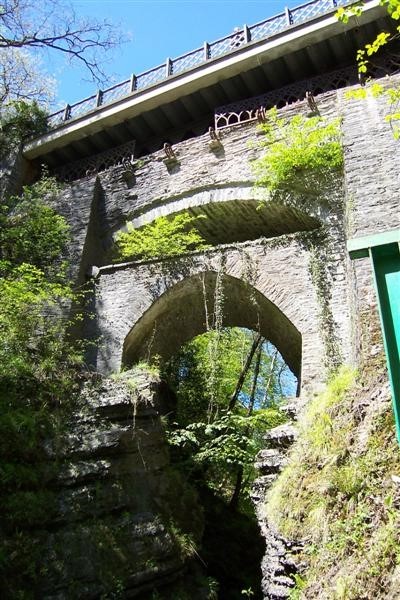
#Devil's Bridge#River Mynach#Rheidol Valley#Wales#AD1188#stone bridges#mediaeval#river gorge#woodland#nature trail#Pontarfynach#Cardiganshire#Dyfed#Rural Britain#UK
17 notes
·
View notes
Text





Aberystwyth (2) (3) (4) (5) by Keiron O'Shea
Via Flickr:
(1) A shot from the Pentre Jane Morgan rural path. (3) Yr Castell (4) Constitution Hill (5) Cliffs off Consti
#overlook#city overview#golden light#evening light#coastal#buildings#ruins#beach#cliffs#ocean#wales#ceredigion#cardiganshire
5 notes
·
View notes
Text
Aberystwyth. Zorki 4. Expired Perutz Primera 100.
Aberystwyth has been a major educational centre in Wales since the mid 1800s when the University College of Wales, now Aberystwyth University was founded. Everyone I meet who attended the university tells me that they loved studying there. I can see why.
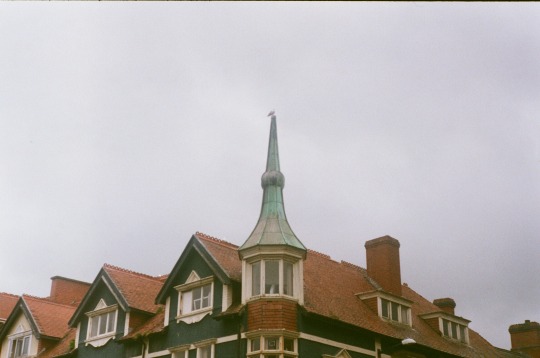


#liverpool#liverpoollomo#lomo#lomography#analogue photography#zorki 4#russian camera#rangefinder#expired film#colour film#35mm film#pirtuz#Aberystwyth#west wales#ceredigeon#Cardiganshire#university town#film is not dead#don't think just shoot#perutz primera 100
9 notes
·
View notes
Text
So I made Pride versions of the flags of the 13 Historic Counties of Wales:
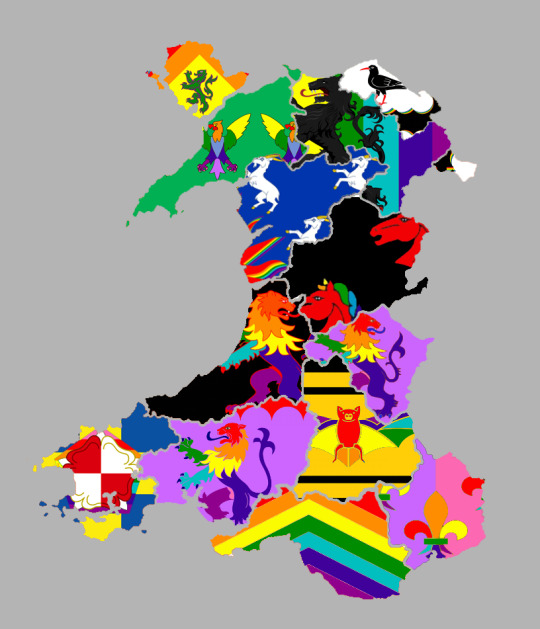
This is the map of Wales with each county flag edited with pride colours! The palette I used was the final Gilbert Baker pride flag which he created before he died. Just for fun and these are free to use with credit.

(Note: several flags are proposed flags, since some counties have not registered official flags yet)
Column 1: Glamorganshire, Cardiganshire, Merionethshire, Montgomeryshire
Column 2: Monmouthshire, Caernarfonshire, Pembrokeshire, Carmarthenshire, Radnorshire
Column 3: Ynys Môn, Flintshire, Brecknockshire, Denbighshire

#eyestrain#lukes originals#bright colours#bright colors#cymraeg#welsh#cwiar#cymru#gilbert baker flag#gilbert baker#lavender stripe#flag edit#county flags#flags of Wales#Wales
337 notes
·
View notes
Text
Happy Christmas Eve y'all! Celebrating by sharing some British superstitions and folktales related to the date. On this day...
Blackthorn comes into flower, because it was the thorn Christ's crown was made of.
In the Kentish town of Hever, the ghost of Anne Boleyn will appear on the bridge of Hever Castle.
Prior to the mid-1960s, the owners of Bloor's Place in Rainham, Kent left out a glass of brandy for the town ghost (a phantom coach drawn by headless horses and driven by a headless coachman and carrying a passenger with his head in his lap) on this night; allegedly, the glass was always empty next morning.
At Hall-i'-the-Wood Manor in Bolton, Lancashire, a phantom cavalier will run up the stairs and will continue doing this until Twelfth Night.
According to the folklore of Lincolnshire, eating a whole Christmas cake today is very unlucky.
In the county of Northumberland, bees gather and hum a hymn on this day.
Also in Northumberland is Bamburgh Castle, where on this day every seven years a toad is seen; this toad is a witch transformed for her evil, who can only be transformed back by unsheathing the Sword of Wynde (a sword used by a dragon-slayer, the Child of Wynde) three times, blowing his horn three times and kissing the toad-witch.
In the village of Westleton in Suffolk, furniture jumps around tonight.
A phantom coach arrives at the manor of Roos Hall in Beccles, Suffolk.
A bell called Black Tom is rung in the Yorkshire town of Dewsbury to ward off the Devil.
At Strata Florida Abbey in the Welsh county of Cardiganshire, a ghostly monk tries to rebuild the altar.
9 notes
·
View notes
Text
Oh! I've never found an ancestor who might be from where I grew up before!
Well, either he's a mariner from Cardiganshire (it's called Ceredigion now) in Kirkdale Prison in 1851, or he's a mariner idk where from but who died in the rigging due to "the inclemency of the weather" in Speke the winter of 1822, or he might be a mariner from who knows where who was in the workhouse infirmary in 1851, I'm not sure which.
I'll just have to write Mariner and leave the rest blank.
I do know his wife was called Jane Taylor tho, and they got married in 1810.
Oh! I could check if they had any more kids past 1822, then I know if he's the poor rigger or the criminal or the pauper - but then it could be either his son-my grandfather is their last kid, or he died, so that's not very definitive.
Hmm.
Ah, there are more kids. But they live in a different street, but it's only a 5 minute walk between them, so it could be the same guy, or there could be two David Lewis's who are mariners in Liverpool at once in the 1820s. There's at least 2 in 1851, I know that.
But two that are both married to Jane's is unlikely. So it's very probably the same guy.
Ugh I hate pre-census work.
Well, I don't, it just takes so loooooong
3 notes
·
View notes
Text
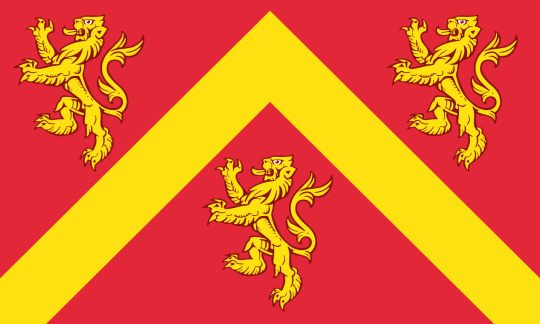

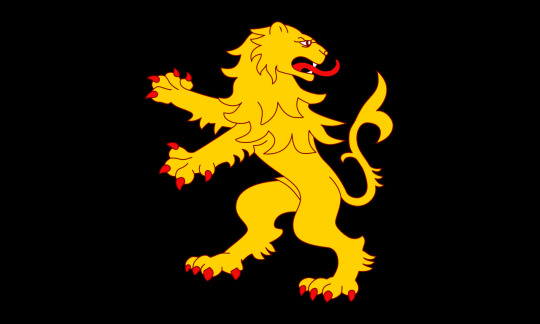





Flag Wars Bonus Round
24 notes
·
View notes
Photo
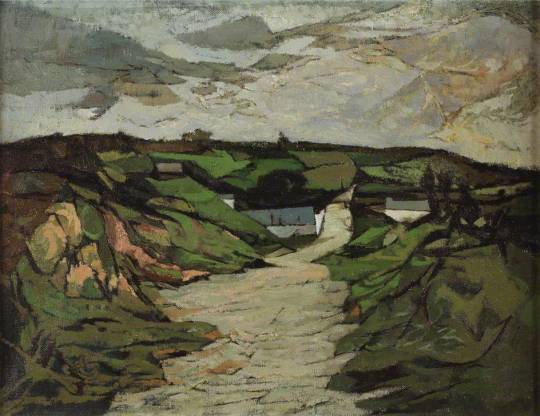
A Cardiganshire Landscape 2 John Elwyn (1916–1997)
8 notes
·
View notes
Text

the sineater 🍞 “Professor Evans of the Presbyterian College, Carmarthen, actually saw a sin-eater about the year 1825, who was then living near Llanwenog, Cardiganshire. Abhorred by the superstitious villagers as a thing unclean, the sin-eater cut himself off from all social intercourse with his fellow creatures by reason of the life he had chosen; he lived as a rule in a remote place by himself, and those who chanced to meet him avoided him as they would a leper. This unfortunate was held to be the associate of evil spirits, and given to witchcraft, incantations and unholy practices; only when a ☠️ took place did they seek him out, and when his purpose was accomplished they burned the wooden bowl and platter from which he had eaten the food handed across, or placed on the corpse for his consumption.”
#artists on tumblr#illustration#folk horror#artbook#diffusion#drawing#horrorart#screenprint#spooky#dark art#sineater#artist#ritual
5 notes
·
View notes
Text
Ceredigion, formerly Cardiganshire (the county) is home to Cardigan (the Town), home of the Cardigan (the garment).
@becausegoodheroesdeservekidneys the Slate museum is also awesome. Sadly, the (nearby) Electric Mountain tours are no longer available :-(
You guuuuuys, you are going to be. So. Jealous. Of what I did today
So Amgueddfa Cymru is the umbrella super museum in Wales, and it is in charge of multiple museums around the country. Seven branches specifically. Entry to each is free, and each commemorates a different facet of Welsh history and culture; of the seven, I had (until a few hours ago) been to five. I've done Caerleon Roman Museum and Amphitheatre, Cardiff Museum, St Ffagan Folk Museum of Welsh Life, Big Pit Coal Mining Museum, and Swansea Waterfront Museum. I have yet to do the Slate Museum in Eryri.
And today, I went to:
The National Wool Museum
YEAH THAT'S RIGHT we have a national wool museum. It's so cool. We arrived at lunchtime so we started in the cafe and we had soup and also cheese and leek Welsh cakes. Except the soup was so Welsh it was correctly served with a piece of cheese:
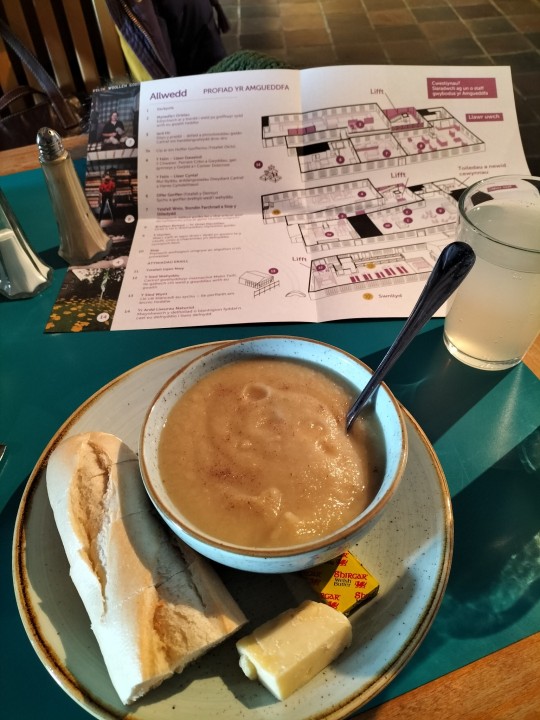
AS IT SHOULD
Anyway, the building was a wool mill once upon a time, and half of the machinery still works, and still produces 100% woollen textiles. Also they run workshops for knitting and weaving and stuff. But you follow the rooms around and they show you the full process, from fleece to flannel.
BUT ALSO at each stop they had little stands where you could try a bit for yourselves. So for example, there was an exhibit where you could card fleece by hand, with a pile of washed fleece beside, and you could just... go ham with the carding.
I deliberately tried not to photograph literally everything. But here's a lil collection:

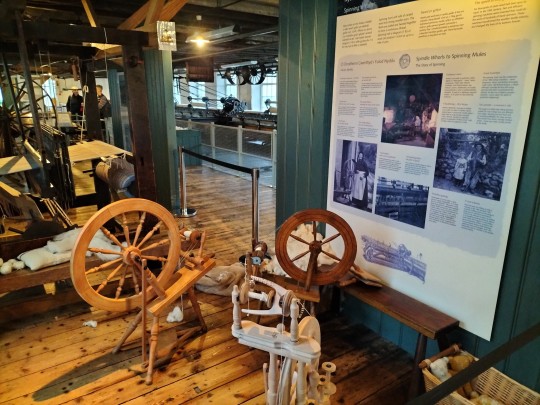

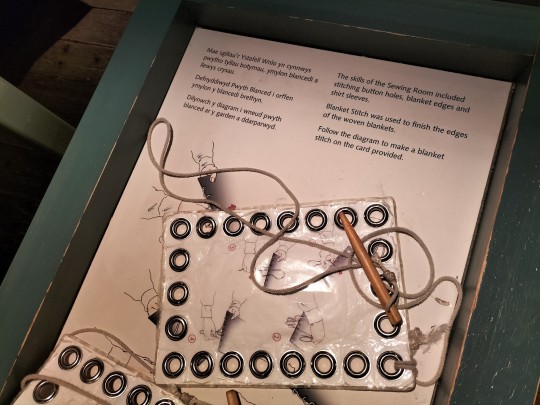
I should have taken a picture of the carding, actually, that was my favourite.
OH MY GOD YEAH and also, they had a section on the uses of the wool. A whole display of traditional Welsh blankets, trad and modern clothes, and, of course, instructions for how to cwtch a baby in a shawl, which was so lovely because that's what my Welsh paternal grandmother taught my English mother to do with me as a baby.
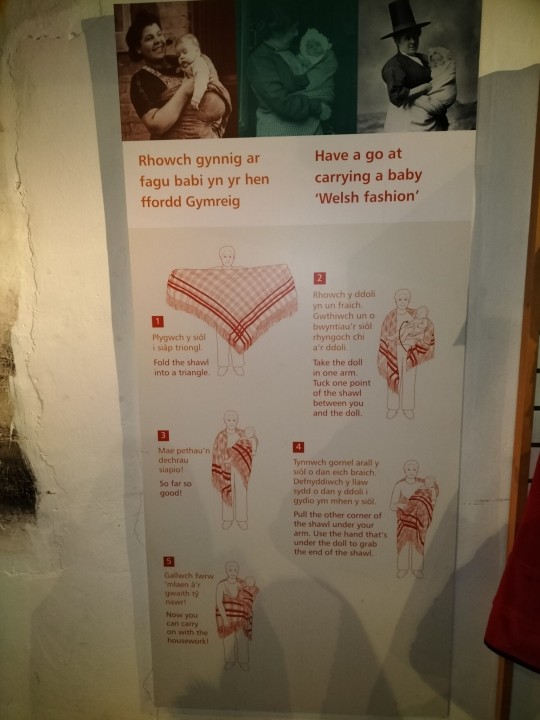
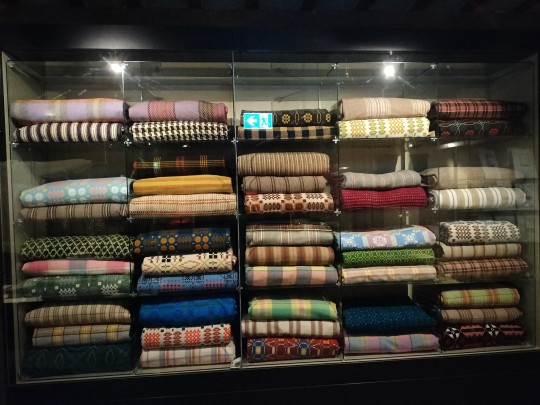
Anyway, then the gift shop sold balls of 100% wool in many fun colours, and tabletop looms, and books on how to knit/weave, and bags of roving that you could spin yourself, and plushie sheep and dragons. And Welsh blankets and shawls/scarves and that.


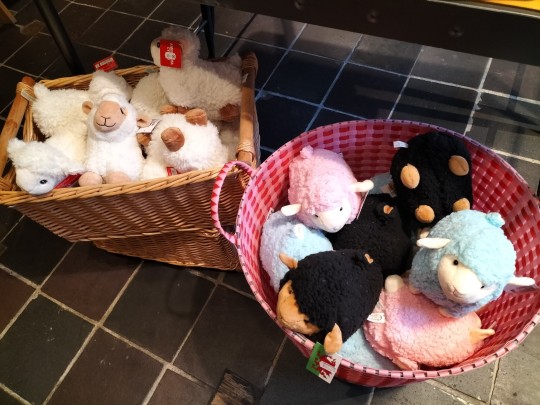
Anyway, you lot are textile nerds. You should all go. It's in the tiniest village in Ceredigion and it is the BEST.
4K notes
·
View notes
Text
A noted witch used to live about a mile and a half from my own home. She was known as "Mary Perlan Peter," from the name of her house "Perllan Peter," deep down in a thickly-wooded ravine, or dingle as we call it in Cardiganshire. This way of designating individuals is common in Wales, where surnames amongst the peasantry are apt to be limited to a few favourites, such as Jones, Davies, Evans, etc. So that a person's Christian name, followed by that of his house, is far more distinctive than using a surname probably common to a third of the people in a parish. Therefore the witch was "Mary of Peter's Orchard" ("perllan" meaning "orchard," though who Peter was, I never found out) and she was undoubtedly a powerful one, as the following stories will show.
A Circle of Witches by Peter Haining
0 notes
Text

SAINTS OF THE DAY FOR MAY 01
St. John-Louis Bonnard,Jean-Louis Bonnard (b. 1 March 1824 at Saint-Christôt-en-Jarret, Diocese of Lyon; beheaded 1 May 1852) was a French Roman Catholic missionary to Vietnam, one of the Martyrs of Vietnam, canonized in 1988,May 1
ST JOSEPH THE WORKER, SPOUSE OF THE BLESSED VIRGIN MARY, PATRON OF WORKERS May 1-St Joseph The Worker, Spouse of the Blessede Virigin Mary, Patron of Workers - https://www.vaticannews.va/en/saints/05/01/st-joseph--the-worker--spouse-of-the-blessede-virigin-mary---pat.html
ST. JEREMIAH, PROPHET Jeremias is the prophet of mourning and of symbolical suffering. This distinguishes his personality from that of Isaias, the prophet of ecstasy and the Messianic future, of Ezechiel, the prophet of mystical (not typical) suffering, and of Daniel, the cosmopolitan revealer of apocalyptic visions of the Old Covenant. May 1
St. Bertha of Kent, The first Christian queen of England, a Frankish princess. She married Ethelbert of Kent, a pagan king, and she brought her chaplain, Luidhard, to the court. Ethelbert welcomed St. Augustine to Kent in 596 . Feastday May 1
St. Asaph, 600 A.D. First bishop of Asaph in Wales also called Asa. He is believed to have lived in a hermitage near Tenegel, near Holywell. He is also described in a life of St. Kentigern, or Mungo. While still young, Asaph served Kentigern. Asked to bring Kentigern a piece of wood for the fire, Asaph brought live coals in his apron, an event that alerted Kentigern to Asaph's sanctity. When Kentigern left the area in 573, Asaph was consecrated a bishop. Asaph's relatives, Deiniol, Tysilo, and others were honored as saints.
St. Brieuc, 510 A.D. Bishop educated by St. Germanus, in Auxerre, France. He is believed to have been born in Dyfed or Cardiganshire, Wales, circa 420. Ordained in France, Brieuc returned to England as a missionary. Known also as Briocus, Briomaglus, or Brioc, he converted his parents and became known for his miracles. He also converted Conan, a local ruler of Brittany, France, and founded a monastery near the present site of the town of Saint-Brieuc in Brittany. He remained in Brittany, dying at the age of ninety. Brieuc is venerated in Cornwall, England, and is credited with stopping a plague.
St. Ceallach, 6th century. Disciple of St. Kiernan, a bishop, sometimes called Kellach or Celsus. He was a bishop of Killala, Ireland, but ended his life as a hermit. Some records list him as a martyr.
0 notes
Text

Cardigan (Welsh: Aberteifi, pronounced is a town and community in the county of Ceredigion, Wales. Positioned on the tidal reach of the River Teifi at the point where Ceredigion meets Pembrokeshire, Cardigan was the county town of the historic county of Cardiganshire. Cardigan is the second-largest town in Ceredigion. The largest town, Aberystwyth, is one of the two administrative centres; the other is Aberaeron.
The settlement at Cardigan was developed around the Norman castle built in the late 11th or early 12th century. The castle was the location of the 1176 Cardigan eisteddfod, precursor of the present-day National Eisteddfod. The town became an important port in the 18th century, but declined by the early 20th century owing to its shallow harbour. The castle underwent restoration in 2014.
The population in 2001 was 4,203, reducing slightly to 4,184 at the 2011 census.
0 notes
Text
Abercynon's Links to Two Chaired Bards
With the National Eisteddfod taking place in Pontypridd I take a look at Abercynon's links to two celebrated poets.
With the National Eisteddfod taking place in Pontypridd, I thought I’d just highlight Abercynon’s links to two of Wales’ most noted bards. John James Williams Born in Taigwynion, Cardiganshire in 1869, Reverend John James Williams was just a child when his family moved to the Cynon Valley. Settling initially in Penrhiwceiber the family then moved to Ynysybwl where they joined Tabernacle…

View On WordPress
#Abercynon#Bardd#Eisteddfod#Glamorgan#Glancynon#Hedd Wyn#J J Williams#Local History#National Eisteddfod#South Wales
0 notes
Text
Post-Apocalyptic Magical Britain - First Post
(Tagging @arcenciel-par-une-larme, @merthwyn, @kaleb-is-definitely-sane and @narulanth, who I've discussed this idea with).
The exact backstory of how magic comes back and how the different states form is something I haven't decided yet, but I have more-or-less hashed out the different states and where they are; their territory is based around this map of the historic counties.
Also, this post is massive, hence the "keep reading".
Annwn
Territory: Cardiganshire, Carmarthenshire, Pembrokeshire
Language: Welsh Faerie-Tongue
Capital: Caer Siddi
Leader: Gwyn ap Nudd
The kingdom of y tylwyth teg (Welsh faeries, literally "the fair family") upon earth, led by their king, Gwyn ap Nudd. Towns are largely abandoned and have been reduced to forests of oak, beech and ash, with the tylwyth teg living beneath lakes and inside barrows and emerging at dusk and disappearing at dawn - to humans travelling by day, the whole land has an eerie quality. Annwn is largely set apart from the wars of its endlessly-feuding neighbours, Cymru and Wales, with the fair folk taking part in their own lives, but during winter, ap Nudd leads sky-borne raids of his spectral white hounds, the Cwn Annwn, targeting both of them and sometimes ranging elsewhere.
Clan Bean
Territory: southern Ayrshire
Language: Scots
Capital: Bennane Head Cave
Leader: Sawney Bean
One of the many folklore figures brought to life was Sawney Bean, the leader of a clan of cave-dwelling cannibal bandits born of incest; while Scotland was collapsing, he and his children assembled a host of outlaws and ne'er-do-wells, and with them he became the ruler of a substantial territory. As loathsome as he and his clan are, they have become adept at using the woods and moors to lay ambushes against invaders, and thus they control the land - but only this land, as their attempts at open-field battle outside their terrain have always been miserable failures. Their settlements are largely caves or clusters of lean-tos, they have little economic activity beside foraging, hunting and robbing travellers foolish enough to pass through the area and they recognise no law but "Old Sawney".
Clan MacLeod
Territory: Isle of Skye, Isle of Lewis
Language: Scots Gaelic
Capital: Dunvegan Castle
Leader: Norman MacLeod
When magic returned, the leaders of Clan MacLeod used the last wish of the Fairy Flag to summon a faerie host to their side, and they promptly allied with them, allowing them to take over the two islands they live on. Today, their political system is well-established: human daughters marry elfin princes and fae princesses become the wives of Adam's sons, and the faerie hills are left undisturbed (save for a payment of food for aid in war) in exchange for the faeries leaving humans alone. The chieftain of Clan MacLeod governs the islands according to clan law codes and his own will, while the people dwell in villages and make their living by keeping sheep, growing oats and catching fish (the society has a broadly 18th-century level of technology). They frequently raid their neighbours (who will be covered later on) and prevail through fae magic.
Cymru
Territory: Anglesey, Caernarfonshire, Denbighshire, Flintshire, Merionethshire
Language: Welsh
Capital: Dinas Emrys
Leader: Owain Glyndwr
When Owain Glyndwr, the great magic-wielding rebel prince of Wales, arose with magic, he went to Cardiff and proposed that he be instated as king and use the Cyfraith Hywel as their laws (complete with slavery, no inheritance for women and no citizenship for immigrants until the fourth generation); the people there were equally outraged and amused. He instead went to the mountains with his followers, an increasingly large band of Welsh-speaking fanatics, and set up his own castle atop Dinas Emrys, the mountain of Myrddin (better known to the English as Merlin). From there, he wages constant war against Wales with both his troops, his tactical ingenuity and his magical powers (he can control the weather and become invisible) while governing as he promised over a population of village-dwelling sheep farmers with a Late Medieval level of technology (Dinas Emrys has grown into a town of some size and sophistication under him).
East Anglia
Territory: Cambridgeshire, Essex, Huntingdonshire, southern Lincolnshire, Norfolk, Suffolk
Language: English
Capital: Norwich
Leader: Tom Hickathrift
With the return of magic, the ancient ecologies came back, and the fens were revived, drowning much of the region. Three centres of civilisation (for a certain definition; all are of an Early Modern technological level) persist - Walsingham, where Our Lady's presence wards off supernatural horrors, Cambridge, where much of the town has holed up inside the university, and chiefly Norwich, where Hickathrift leads a band of monster slayers, with Hereward the Wake as his second-in-command. And there are many monsters to slay - Lantern Men (ghosts who lead travellers in the marshes astray), the Shug Monkey (a half-dog, half-monkey creature in southern Cambridgeshire), child-eating mermaids in pools, and above all, Black Shuck, the dread hellhound who appears in thunderstorms to maim and kill. Outside the three towns, most settlements are fishing and herding villages, in a High Medieval or lower technological state due to their isolation and living in terror of the demons of the swamp.
Elphame
Territory: Dumfriesshire, Kirkcudbrightshire, Wigtownshire
Language: Scots
Capital: Mid Gleniron
Leader: The Fairy Queen
The territory of the faeries in the Scottish Lowlands, given to them by William Wallace in exchange for her aid in the war against the democratic government of Scotland. They now inhabit its hills and barrows, emerging by night in the land that (since Wallace's Scotland took them all) is nearly devoid of humans to dance atop the moors; humans who do trespass there find themselves imprisoned and enslaved in Faerie-Land. It retains warm relations with Scotland, but every other nation dreads interacting with them for reasons that should be clear.
Highland
Territory: Argyllshire, Cromartyshire, Inverness-shire, northern Perthshire, Ross-shire, Sutherland
Language: Scottish Gaelic
Capital: Schiehallion
Leader: The Cailleach
This land has been taken by the Cailleach, the Gaelic goddess of winter, and it shows. The entire landscape is an austere snow-blanketed pine forest where wolves howl, deer and boar cavort and eagles make their nests, with only a few human settlements (most of them post-apocalyptic farmsteads) amidst the huge numbers of fae folk, kelpies, sluagh and so on, who all pay fealty to her in her court at Schiehallion. She endeavours to spread her territory, and has several times made war against Scotland for that end, but has thus far been rebuffed - her greatest enemy currently, however, is the Nordøjar, who have established a colony in the Highlands which they must constantly struggle to maintain.
Isle of Man
Territory: Isle of Man
Language: Manx, English
Capital: Peel Castle
Leader: Manannan
In times of trouble and the rise of magic, the sea god Manannan returned to the island, protecting it with his mists as he did in ancient times. The island, however, came to have a different folkloric denizen - Sir Francis Drake, who betrayed the English Crown in order to serve King Arthur and had his loyalty to Britain (and his heart) destroyed by being rebuffed by Arthur. Now, he is a pirate, and uses Manannan's mists to hide his crew (and that of other Manx privateers) while they retreat from the ships and coastal villages they raid. Hence, the Isle of Man is now full of nests of pirates (with 16th-17th century technology and clothes) sharing and selling what they have taken - food, clothes, livestock, valuables, human captives - in the midst of a countryside thick with glashtyns, bugganes and other such monsters.
Kernow
Territory: Cornwall
Language: Cornish, Briton
Capital: Tintagel Castle
Leader: Sir Lancelot, Sir Mertraut/Mordred
When King Arthur was revived with his wife, Lancelot and Mertraut (the latter better known by his French name, Mordred) still lusted after Gwenhwyfar (again, better known by her French name, Guinevere), which boiled over when Arthur offered Lancelot anything for his victory against the United Kingdom, and Lancelot asked for Gwenhwyfar. Thus, Lancelot and Mertraut rebelled, leading an army of spriggans, giants, mermaids, giant black cats and so on alongside Cornish humans, and with Lancelot going to his foster mother, the Lady of the Lake, in Dozmary Pool, receiving a sword of the grade of Excalibur. They are perpetually at war with Arthur and his kingdom of Logres, but have had little success; Lancelot and Mertraut quarrel with each other frequently, and are delaying the question of who will receive Gwenhwyfar if they win. The two are equally divided in ruling their land in non-military matters, which (in the few surviving human settlements) has a High Medieval technological level and an economy built on fishing and sheep-herding.
Kingdom of England
Territory: Leicestershire, northern and central Lincolnshire, Northamptonshire, Nottinghamshire, Rutland
Language: English
Capital: Kenilworth Castle
Leader: Queen Gloriana
The remnants of England, this land - Elizabethan in aesthetics and technology, and with an agrarian economy and several substantial towns, the greatest of which is Leicester - is ruled by Gloriana, the deified ever-virgin spirit of Queen Elizabeth I. The rest of the land is governed feudally, with territory being given out to her subordinates, such as Francis Walsingham and Robert Dudley (with the notable exception of Sir Francis Drake, who decided that Arthur commanded a higher loyalty than Gloriana. She is the primary force preventing the Republic of York from conquering territory further south, but still finds time to feud with Mercia to the west (both are of the opinion there is room for only one queen in the Midlands) and broker deals with the United Kingdom in the hope of obtaining royal treasures from the Tower of London (a futile attempt, as the Tower of London is blocked off from mortal visitation due to the density of ghosts). The greatest thorn in her side, however, is Robin Hood, the de facto leader of northern Nottinghamshire who continues to rob from the rich to give to the poor.
Kingdom of Scotland
Territory: northern Ayrshire, Buteshire, Clackmannanshire, Dunbartonshire, East Lothian, Lanarkshire, Midlothian, Peeblesshire, southwestern Perthshire, Renfrewshire, Selkirkshire, Stirlingshire, West Lothian
Language: Scots
Capital: Edinburgh
Leader: William Wallace
When William Wallace returned and led the army that secured Scottish independence, he expected to be given the crown in return; he was not, and so civil war broke out. After agreeing to give away land in exchange for alliances, he ousted the democratic faction from Scotland and installed himself as king. The land now has a High Medieval technology level, a vassalage-based political system where lairds and earls swear loyalty to Wallace in exchange for being given land (including Michael Scot, who has been pledged his birth county of Selkirkshire in perpetuity), and an economy based on farming oats and sheep. The land is perennially in one war or another, usually with the Cailleach to the north or the Reavers to the south.
Logres
Territory: Devon, Dorset, Gloucestershire, Somerset, Wiltshire
Language: Briton
Capital: Camelot
Leader: Arthur
One of the first signs of the return of magic was Arthur arising from Glastonbury Abbey with a small number of loyal knights, and quickly defeating the United Kingdom (notwithstanding the schism detailed above). Thus, he has developed a High Medieval kingdom in the West Country, where the peasants (the people have adapted to this lifestyle under Arthur's wise and benevolent leadership) grow wheat and keep cattle and sheep, in exchange for defence by the knights in their castles - or that would be the case, if the knights were not perpetually at war with Kernow. In addition, they have also at times made war with Mercia, due to being modern representatives of the Saxons Arthur hated, but upon discovering them to be Christian he is largely at peace with them.
Mercia
Territory: Derbyshire, Shropshire, Staffordshire, Warwickshire, Worcestershire
Language: Old English
Capital: Coventry
Leader: Lady Godiva
This territory is inhabited by pre-Conquest Englishmen, and has all the appropriate trappings - people live in longhouses, have an agrarian economy and an Early Medieval level of technology, speak Old English and practice Christianity in small stone churches. Their leader, Lady Godiva, has cultivated good relations with both Wales and Cymru, becoming skilled at playing them off against each other so they do not trouble her, has historically fought with (but is now allied with) Logres and now has her main enemies in the Kingdom of England and the Republic of York, both of which her trained bands of warriors fight vigorously.
Nordøjar
Territory: Caithness, Orkneys, Shetlands
Language: Norn
Capital: Kirkavå
Leader: Assipattle
The Northern Isles (or Nordøjar, as they are now known) are the islands off the tip of Scotland, united in a federation by the hero Assipattle, who from his seat in Kirkwall (as it used to be known) persuaded the inhabitants of the isles to renounce Christianity and become Norse, raiding the seas in longships as they plough the land while living in longhouses (their main economic activities aside from raiding are peat digging, fishing and sheep-herding). Their usual targets are various areas around Scotland, although they have ranged further south on occasion, and frequently sell their wares on the Isle of Man. They are opposed by the Kingdom of Scotland and the Republic of Aberdeen, but are nonetheless largely able to raid due to their maritime skill and Assipattle's host of creatures such as trows, the wulver and the dread nuckelavee. However, their greatest enemy is the Cailleach, whose forces they constantly struggle against as they seek to maintain their Caithness colony.
Reaver Lands
Territory: Berwickshire, Cumberland, Northumberland, Roxburghshire
Language: English, Scots
Capital: Liddesdale
Leader: None
The Border is a wasteland of tree-bare hills, populated chiefly by sheep, ponies and raiding parties both human and otherworldly. On the human side are the Border Reavers, the pony-riding bandit clans who live in turf cabins and stone towers and ride over the hills to steal the livestock of or take revenge on some other clan. On the otherworldly side is the Fairy Rade, the hosts of faerie archers mounted on white horses with harnesses jingling with bells, who come hunting through the night. Mediating between the two is Thomas the Rhymer, the faerie-gifted poet-prophet who knows the ways of both sides. Only fools or the desperate travel through this land; everyone else who can uses boats around the region. While it has no true leader or capital, Liddesdale is the centre of the region and the most common point of gathering.
Republic of Aberdeen
Territory: Aberdeenshire, Angus, Banffshire, Fife, Kinross-shire, Kincardineshire, Morayshire, southeastern Perthshire
Language: Scots, English
Capital: Aberdeen
Leader: Martha Seward (no, that's not a folklore character, yes, that's intentional - you'll see why)
The territory controlled by the democratic faction, ousted from Edinburgh by William Wallace's troops. The economy here is largely industrial - or rather, attempting to be industrial, seeing as even steam power is increasingly failing. Many cities (in which the majority of people live) are derelict, and while the nation still professes democracy, the "emergency government" has now held power for nearly ten years. The nation's chief ally is the United Kingdom (hence the perception of them as traitors by Scottish nationalists, who hence sided with Wallace), another relict modern democracy, but which can help them little against the attacks of the Cailleach and Assipattle's raiders - however, those same attacks mean that the Kingdom of Scotland rarely has time to attack them.
Republic of York
Territory: Cheshire, Durham, Lancashire without the exclave, Westmorland, Yorkshire
Language: English
Capital: York
Leader: Mother Shipton
One of the larger and more successful states to come out of the collapse, the Republic of York has been given power by a few factors - Mother Shipton's prophetic gifts giving them the ability to make excellent political decisions, a relatively undamaged economy (technology has regressed to "just" the 19th century, and the aesthetics, culture and economy of the society are largely Victorian) and a large base of land and population. Thus, they annexed much of northern England, but have been running out of steam for a few reasons - a long and fruitless war in the Reaver Lands, their technology slowly breaking down, and a crushing defeat delivered to them by the Kingdom of England. However, they remain powerful, and hence are unperturbed by possessing few allies; they need little other than themselves.
United Kingdom
Territory: Bedfordshire, Berkshire, Buckinghamshire, Hampshire, Hertfordshire, Kent, Middlesex, Oxfordshire, Surrey, Sussex
Language: English
Capital: London
Leader: Winston Churchill
The remnant of the old United Kingdom, whose failure to adapt to magic and the end of modern technology meant they kept experiencing defeat after defeat and a steady loss of territory, reducing them to the southeast corner of England, until their leaders realised that the Second World War was now English folklore. Thus, they summoned an avatar of Winston Churchill to lead them, and now make their tanks, guns and planes work by magic. They have hence been able to win victories - a naval operation in Essex and an overland operation in the New Forest (which at the time was a de facto independent territory ruled by Yernagate and populated mainly by pixies) have had promising results, and an attack on Logres is in the works. The price for the average citizen, however, is steep - to summon the spirit of the Blitz, people live on rationed food in air raid shelters and bombed-out houses and Winston Churchill is king in all but name.
Wales
Territory: Brecknockshire, Glamorgan, Herefordshire, Monmouthshire, Montgomeryshire, Radnorshire
Language: English, Welsh
Capital: Cardiff
Leader: Joseph Morgan (also not a folklore figure; that's important)
The last true democracy and one of the last modern societies in Britain, Wales is a largely urban and industrial society (although their cities and industry are rapidly crumbling), struggling mightily against Cymru and Annwn - however, with the aid of Davies Sirevan and Jack of Kent, their resistance is successful.
4 notes
·
View notes
